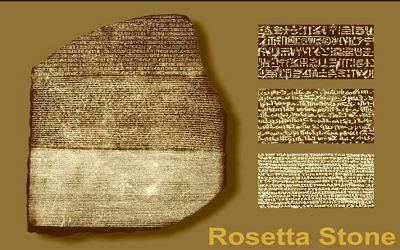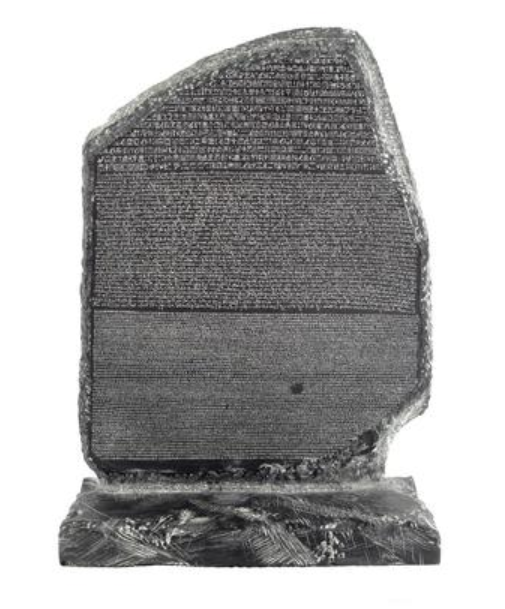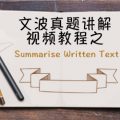PTE换题季又来了!继去年5月8号,11月之后,3月18号19号PTE又开始大规模的换题了!今天墨尔本悉尼霍巴特阿德莱德文波PTE培训学校继续给大家带来PTE真题系列:今天给大家讲讲罗塞塔石:
The Rosetta Stone is a granodiorite stele, found in 1799, inscribed with three versions of a decree issued at Memphis, Egypt in 196 BC during the Ptolemaic dynasty on behalf of King Ptolemy V. The top and middle texts are in Ancient Egyptian using hieroglyphic script and Demotic script, respectively, while the bottom is in Ancient Greek. As the decree has only minor differences between the three versions, the Rosetta Stone proved to be the key to deciphering Egyptian hieroglyphs.
The stone, carved in black granodiorite during the Hellenistic period, is believed to have originally been displayed within a temple, possibly at nearby Sais. It was probably moved during the early Christian or medieval period, and was eventually used as building material in the construction of Fort Julien near the town of Rashid (Rosetta) in the Nile Delta. It was rediscovered there in July 1799 by a French soldier named Pierre-François Bouchard during the Napoleonic campaign in Egypt. It was the first Ancient Egyptian bilingual text recovered in modern times, and it aroused widespread public interest with its potential to decipher this previously untranslated hieroglyphic language. Lithographic copies and plaster casts began circulating among European museums and scholars. Meanwhile, British troops defeated the French in Egypt in 1801, and the original stone came into British possession under the Capitulation of Alexandria and was transported to London. It has been on public display at the British Museum almost continuously since 1802 and is the most-visited object there.
Study of the decree was already under way when the first full translation of the Greek text appeared in 1803. It was 20 years, however, before the transliteration of the Egyptian scripts was announced by Jean-François Champollion in Paris in 1822; it took longer still before scholars were able to read Ancient Egyptian inscriptions and literature confidently. Major advances in the decoding were recognition that the stone offered three versions of the same text (1799); that the demotic text used phonetic characters to spell foreign names (1802); that the hieroglyphic text did so as well, and had pervasive similarities to the demotic (Thomas Young, 1814); and that, in addition to being used for foreign names, phonetic characters were also used to spell native Egyptian words (Champollion, 1822–1824).
Ever since its rediscovery, the stone has been the focus of nationalist rivalries, including its transfer from French to British possession during the Napoleonic Wars, a long-running dispute over the relative value of Young and Champollion’s contributions to the decipherment and, since 2003, demands for the stone’s return to Egypt.
Two other fragmentary copies of the same decree were discovered later, and several similar Egyptian bilingual or trilingual inscriptions are now known, including two slightly earlier Ptolemaic decrees (the Decree of Canopus in 238 BC, and the Memphis decree of Ptolemy IV, c. 218 BC). The Rosetta Stone is, therefore, no longer unique, but it was the essential key to modern understanding of Ancient Egyptian literature and civilisation. The term Rosetta Stone is now used in other contexts as the name for the essential clue to a new field of knowledge.
中文背景罗塞塔石碑(英语:Rosetta Stone,又译为罗塞达碑),是一块制作于公元前196年的花岗闪长岩石碑,原本只是一块刻有古埃及法老托勒密五世诏书的石碑,但由于这块石碑同时刻有同一段内容的三种不同语言版本,使得近代的考古学家得以有机会对照各语言版本的内容后,解读出已经失传千余年的埃及象形文之意义与结构,而成为今日研究古埃及历史的重要里程碑。罗塞塔石碑最早是在1799年时由法军上尉皮埃尔·弗朗索瓦·札维耶·布夏贺(Pierre-François Xavier Bouchard)在一个埃及港湾城市罗塞塔(今日亦称为拉希德)发现,但在英法两国的战争之中辗转到英国手中,自1802年起保存于大英博物馆中并公开展示。







It was a really difficult and long text but finally made it through. Thank you for your contributions. I hope I managed to touch to the key points.
Rosetta Stone used in contexts to describe a vital clue to a new field of knowledge derives from the first bilingual stele discovered in 1799 engraved with the same decree in different languages in 196 BC, Egypt, which facilitated the transliteration of Egyptian hieroglyphic text with the help of advanced decoding techniques as well as similar phonetic characters, and helped to gain insight into Egyptian literature and civilisation.